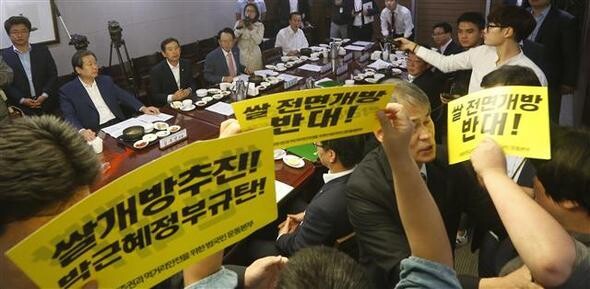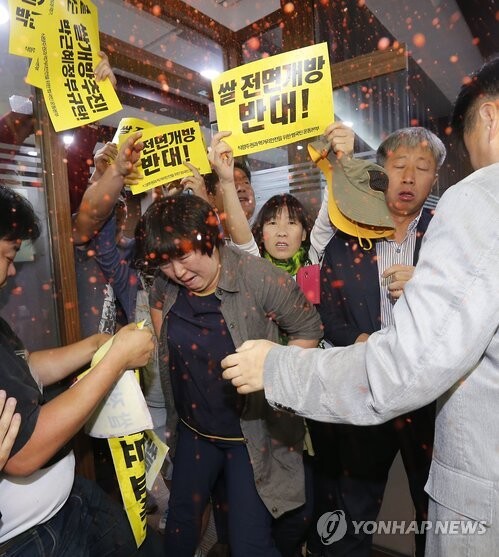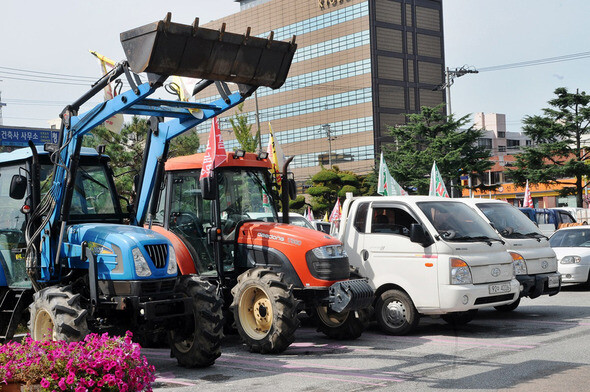hankyoreh
Links to other country sites 다른 나라 사이트 링크
[Analysis] Will rice tariff rate of 513% pass WTO vetting?

By Kim Kyung-moo, agriculture correspondent
Will South Korea’s plans for a 513% tariff rate on rice pass vetting by World Trade Organization member countries? And will it be enough to protect the country’s imperiled rice market?
Minister of Agriculture, Food and Rural Affairs Lee Dong-pil addressed the issue at a press conference following the announcement of the 513% rate on Sept. 18.
“The South Korean government has the authority to decide the tariff rate,” Lee said.
But he also predicted a rough road for Seoul’s decisions on full rice market openness, and what he said would be a “tedious and difficult process of vetting by other WTO countries.”
Lee went on to say the decision would “have to follow the guidelines and calculation formulas of the WTO Agriculture Agreement”, although he added that it would not be a problem because the guidelines and formulas were used as a basis for the chosen rate.
Deputy minister Lee Joon-won also expressed confidence, saying the rice tariff rate was “set at a logically defensible level.”
When asked if Seoul had reached out beforehand to Washington or China, Lee said, “We didn’t have any concrete discussions, but we did investigate what their interests are.”
As indicated in an annex to the Agriculture Agreement from the Uruguay Round of multilateral trade negotiations, rice tariff rate calculations follow a simple formula of dividing the difference between domestic and international prices by international prices. In other words, the percentage is determined by subtracting international import prices from domestic rates, then dividing by the import price and multiplying by one hundred.
The ministry explained that representative wholesale prices from a Korea Agro-Fisheries and Food Trade Corporation (aT) survey were used for domestic prices, while the average import price for neighboring China was used for an international rate, with reference years of 1986 to 1988.
“Because the international rate is now much higher than in the reference year for the tariff rate calculation, we decided to also apply an ad valorem tariff, which has a relatively strong protection effect,” the ministry said.

With the 513% rate, an 80-kilogram bag of medium-grain US rice, which cost 63,303 won (US$60.65) in 2013, would acquire a 324,746 won (US$311.15) tariff, bringing the import price all the way up to 388,049 won (US$371.80). For China, the import price would be 522,134 won (US$500.27); for Thailand, 277,259 won (US$265.65). In all three cases, the amount would be well above the 166,764 won (US$159.78) price for locally produced rice as of Sept. 15.
The government had previously talked about a tariff rate between 300% and 500%. The rate it ultimately came up with was above even the 500% that farmers’ groups had been demanding.
“We established a rice industry development council on Aug. 15 and have held six meetings since then, with farmers’ groups [including the Korea Farmers’ League] taking part,” explained Lee Dong-pil. “There had been talk about a tariff rate of around 500%, so this isn’t out of the blue.”
Seoul also arranged for a “special safeguard” to take effect by further raising the rate and protecting the domestic market if the new tariff system causes imports to rise above a certain level. For example, if imports rise by 5% from their average for the preceding years, an additional one-third would be added to the tariff.
“Last year, we imported 400,000 tons, so if it increases by 5%, or 20,000 tons, we would impose an additional 170% tariff,” explained Lee Joon-won.
Farmers’ groups are still unhappy about the decision, since it failed to block the tariff system outright.
“The more important thing here is the promise [the government] made to the people of South Korea that it would keep rice off the table for concessions during its future Free Trade Agreement negotiations,” said Park Hyeong-dae, chief of the Korea Farmers’ League policy office.
The groups are now skeptical about whether Seoul can stick to its promise to keep rice off the list of possible areas for concession in international negotiations.
“513% is the highest rate South Korea is allowed to impose, but the latest rice industry development measures aren’t going to be enough to soothe the fears that farmers have,” said Son Jae-beom, secretary-general of the Korean Advanced Farmers’ Federation.
Lee Jeong-hwan, chairman of the agricultural research institution GS&J, said the tariff was “well chosen, given that it was the highest rate among the ones the experts were considering.”
“But it’s also going to be important to defend it effectively and with sound logic during the WTO examination process,” he added.

Please direct questions or comments to [english@hani.co.kr]

Editorial・opinion
![[Guest essay] The real reason Korea’s new right wants to dub Rhee a founding father [Guest essay] The real reason Korea’s new right wants to dub Rhee a founding father](https://flexible.img.hani.co.kr/flexible/normal/500/300/imgdb/original/2024/0423/8317138574257878.jpg) [Guest essay] The real reason Korea’s new right wants to dub Rhee a founding father
[Guest essay] The real reason Korea’s new right wants to dub Rhee a founding father![[Column] ‘Choson’: Is it time we start referring to N. Korea in its own terms? [Column] ‘Choson’: Is it time we start referring to N. Korea in its own terms?](https://flexible.img.hani.co.kr/flexible/normal/500/300/imgdb/original/2024/0423/3617138579390322.jpg) [Column] ‘Choson’: Is it time we start referring to N. Korea in its own terms?
[Column] ‘Choson’: Is it time we start referring to N. Korea in its own terms?- [Editorial] Japan’s rewriting of history with Korea has gone too far
- [Column] The president’s questionable capacity for dialogue
- [Column] Are chaebol firms just pizza pies for families to divvy up as they please?
- [Column] Has Korea, too, crossed the Rubicon on China?
- [Correspondent’s column] In Japan’s alliance with US, echoes of its past alliances with UK
- [Editorial] Does Yoon think the Korean public is wrong?
- [Editorial] As it bolsters its alliance with US, Japan must be accountable for past
- [Guest essay] Amending the Constitution is Yoon’s key to leaving office in public’s good graces
Most viewed articles
- 1[Column] ‘Choson’: Is it time we start referring to N. Korea in its own terms?
- 2Why Korea shouldn’t welcome Japan’s newly beefed up defense cooperation with US
- 3Senior doctors cut hours, prepare to resign as government refuses to scrap medical reform plan
- 4[Guest essay] The real reason Korea’s new right wants to dub Rhee a founding father
- 5Samsung barricades office as unionized workers strike for better conditions
- 6Opposition calls Yoon’s chief of staff appointment a ‘slap in the face’
- 7[Column] The clock is ticking for Korea’s first lady
- 8[Editorial] Japan’s rewriting of history with Korea has gone too far
- 9New AI-based translation tools make their way into everyday life in Korea
- 10Terry Anderson, AP reporter who informed world of massacre in Gwangju, dies at 76